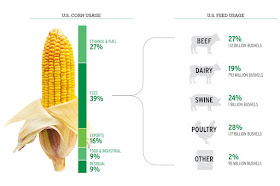 |
| September corn field
Photo by J. Harrington
|
Most of Minnesota's cropland produces corn and soybeans. (I never eat field corn but munch too many snacks made with corn products.) According to the Iowa Corn Growers Association, the following represents a breakdown of the end uses for corn:
 |
| Corn Uses: Iowa Corn Growers Association |
We're still looking for comparable information for soybeans. From this quick overview, we can think of no reason why row crops should be exempt from water quality requirements. We strongly question whether American farmers are "feeding the world" (27% of corn goes to ethanol production). If some of the oil and gas production facilities are subject to stormwater discharge permits, why aren't the larger farms subject to similar requirements? For that matter, as the world moves toward eliminating subsidies for fossil fuels, the US should aggressively consider imposing more stringent water quality discharge requirements on oil and gas production facilities. It's past time we followed the basic strategy of taxing and regulating what we want less of more onerously than those things we want more of, things we depend on to provide us with clean air and water. The way we produce row crops needs transformation.
Corn Maze
By David Barber
Here is whereYou can get nowhereFaster than everAs you go underDeeper and deeperIn the fertile smotherOf another acreLike any otherYou can’t peer overAnd then anotherAnd everywhereYou veer or hareThere you areFarther and fartherAfield than beforeBut on you blunderIn the verdant meanderAs if the answerTo looking for coverWere to bewilderYour inner minotaurAnd near and far wereNeither here nor thereAnd where you areIs where you were
No comments:
Post a Comment